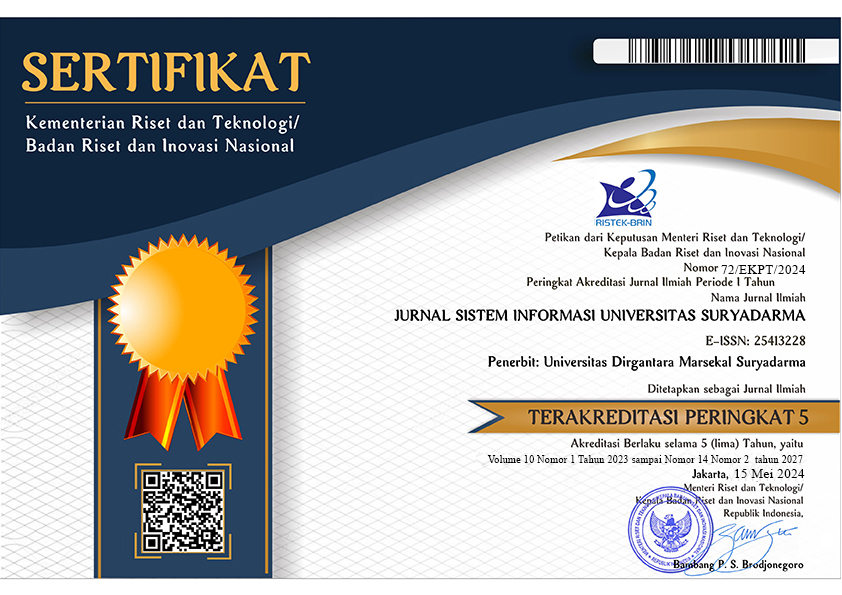
PENERAPAN RADIO FREQUENCY IDENTIFICATION PADA SISTEM INFORMASI PERPUSTAKAAN SEBAGAI ALAT BANTU MAHASISWA UNIVERSITAS XYZ
Sari
The library is part of the learning resources that must be possessed by every field of education including universities. Because with the existence of a library it is expected that students can more easily find information or knowledge through a library. With the development of technology makes people think to be able to work more effectively and efficiently. One of them is to simplify activities in the library into a system that can help the process of activities at the university. By utilizing Radio Frequency Identification (RFID) technology, libraries can cut time. So that it can accelerate and simplify existing activities. In this study applying a web-based information system and utilizing RFID technology as a tool to facilitate students and library officers. With this system, it is expected to be able to overcome the various needs of students to search for books and conduct loans and make it easier for officers to circulate books and make reports. From the results of the research that has been done, the writer poured the results of the research into the Application of RFID Technology Information System as Electronic Access at the Aerospace University Marshal Suryadarma Library.
Keywords: RFID, Library, Information System
Referensi
Adhiarna, N., Hwang, Y. M., Park, M. J., & Rho, J. J. (2013). An integrated framework for RFID adoption and diffusion with a stage-scale-scope cubicle model: A case of Indonesia. International Journal of Information Management, 33(2), 378–389.
Akbar, M., & Effendy, I. (2017). Implementasi Aplikasi Kehadiran Perkuliahan Dikelas Menggunakan Pembaca RFID Pada e-KTP. Informatika, xx(xx), 31–35.
Anthadi, A., Amin, W., & Darjat. (2013). Pemanfaatan Teknologi Rfid Untuk Sistem Multi Akses Mahasiswa. Transmisi, 15 Nomor 1, 8–12.
Andersons, A., & Ritter, S. (2015). Advanced RFID applications for sports events management: The case of SPORTident in Latvia. Procedia Computer Science, 43(C), 78–85.
Arif, O. I., Seminar, M., Membangun, S., & Perpustakaan, J. (2003). Konsep dan Perencanaan dalam Automasi Perpustakaan. Konsep Dan Perencanaan Dalam Automasi Perpustakaan.
Beal, V. (2015). Client-Server Architecture. Webopedia
Cej, V., Giunio, K., & Silić, T. (2013). RFID technology in Zagreb City libraries . Vjesnik Bibliotekara Hrvatske.
Constance, E. (2017). The Internet of Things: preparing for the revolution. Journal of Cyber Policy (Vol. 2).
Cui, B., Wang, Z., Zhao, B., & Chen, X. (2016). Design and analysis of secure mechanisms based on tripartite credibility for RFID systems.
D., H., Salih, N., Al, A., Al-Sadawi, B., & Alsharqi, H. (2018). Attendance and Information System using RFID and Web-Based Application for Academic Sector. International Journal of Advanced Computer Science and Applications, 9(1), 266–274.
Druml, N., Schilling, J., Pachler, W., Roitner, B., Ruprechter, T., Bock, H., & Holweg, G. (2017). Secured miniaturized system-in-package contactless and passive authentication devices featuring NFC. Microprocessors and Microsystems, 53, 120–129.
Duroc, Y., & Tedjini, S. (2018). La RFID : une technologie clé au service de l’humanité. Comptes Rendus Physique, 19(1–2), 64–71.
Firmansyah Agustian. (2014). Adobe Dreamweaver. Jurnal Desain web. https://doi.org/2016-06-23
Hameed, S., Saquib, S. M. T., Hassan, M. ul, & Junejo, F. (2015). Radio Frequency Identification (RFID) Based Attendance & Assessment System with Wireless Database Records. Procedia - Social and Behavioral Sciences, 195, 2889–2895.
Husemann, D. (2001). Standards in the smart card world. Computer Networks, 36(4), 473–487.
Hu, Q., Dinca, L. M., Yang, A., & Hancke, G. (2016). Practical limitation of co-operative RFID jamming methods in environments without accurate signal synchronization. Computer Networks, 105, 224–236.
Ilie-Zudor, E., Kemény, Z., Van Blommestein, F., Monostori, L., & Van Der Meulen, A. (2011). A survey of applications and requirements of unique identification systems and RFID techniques. Computers in Industry, 62(3), 227–252.
Jia, X., Feng, Q., Fan, T., & Lei, Q. (2012). RFID technology and its applications in Internet of Things (IoT). In 2012 2nd International Conference on Consumer Electronics, Communications and Networks (CECNet).
Joshi, Y., Gharate, P., Ahire, C., Alai, N., & Sonavane, S. (2016). Smart book management system using RFID and OCR. In International Conference on Energy Systems and Applications, ICESA 2015.
Jyothi, S. N., & Vardhan, K. V. (2016). Design and implementation of real time security surveillance system using IoT. In Proceedings of the International Conference on Communication and Electronics Systems, ICCES 2016.
Louw, L., & Walker, M. (2018). Design and implementation of a low cost RFID track and trace system in a learning factory. Procedia Manufacturing, 23(2017), 255–260.
Oluwatosin, H. S. (2014). Client-Server Model. IOSR Journal of Computer Engineering.
Rachmat, H. H., & Hutabarat, G. A. (2014). Pemanfaatan Sistem RFID sebagai Pembatas Akses Ruangan. Jurnal ELKOMIKA Institut Teknologi Nasional Bandung.
Satoglu, S. I., Ustundag, A., & Kilinc, M. S. (2013). Value of RFID in library management system. In The Value of RFID: Benefits Vs. Costs.
Waytz, A., & Epley, N. (2012). Social connection enables dehumanization. Journal of Experimental Social Psychology.
Weijun, Z., & Changqing, C. (2012). To achive a Campus Interchangeable Card Based on RFID Technology. Energy Procedia.
Widianto, E. D., Wijaya, H. M., & Windasari, I. P. (2017). Sistem Parkir Berbasis RFID dan Pengenalan Citra Pelat Nomor Kendaraan. Jurnal Teknologi Dan Sistem Komputer, 5(3), 115.
Williamson, “Avery, Tsay, L.-S., Kateeb, I. A., & Burton”, L. (2013). “Solutions for RFID Smart Tagged Card Security Vulnerabilities.” AASRI Procedia, 4, 282–287.
Zahedi, A. (2008). MASTER ’ S THESIS Intention to Adopt Smart Cards Case of Application in Universities Intention to Adopt Smart Cards ; Case of Application Supervisors :
DOI: https://doi.org/10.35968/jsi.v6i2.326
Refbacks
- Saat ini tidak ada refbacks.
Indexed by:





